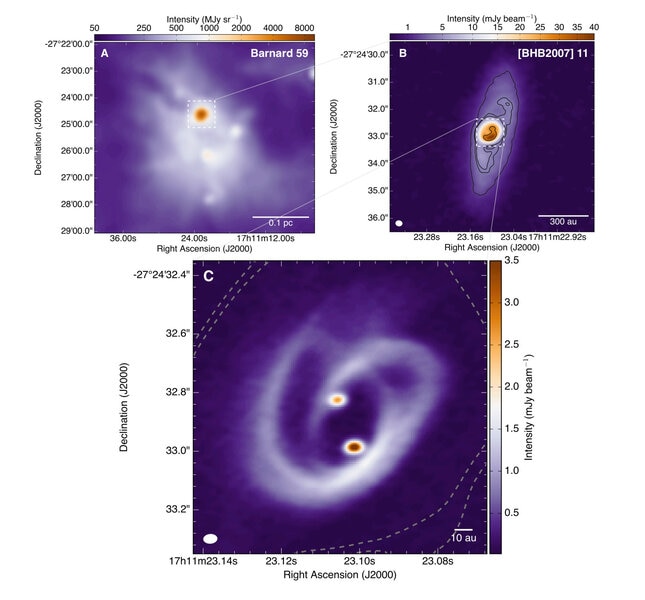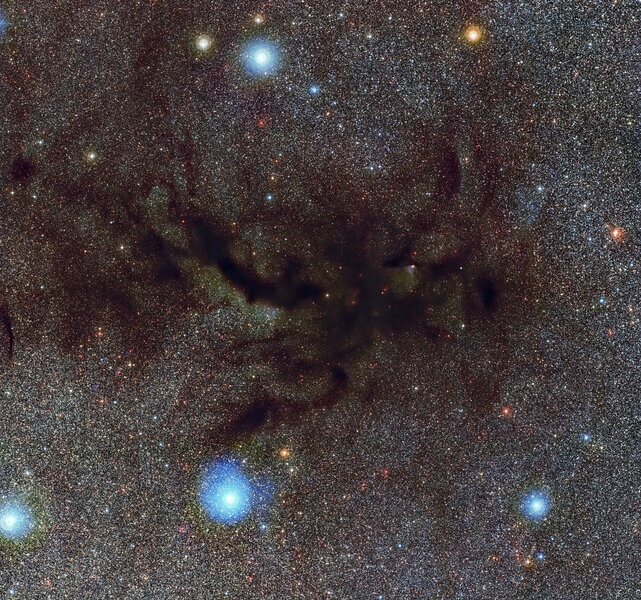Create a free profile to get unlimited access to exclusive videos, sweepstakes, and more!
ALMA sees the twisted birth of a binary star system
![The two stars of the binary system [BHB2007] 11 are in the process of forming, drawing material from the disk surrounding both via a pair of filaments, wound up due to the motion of the stars around each other. Credit: ALMA (ESO/NAOJ/NRAO), Alves et al.](/sites/syfy/files/alma_binarystars.jpg)
Roughly half of all stars you see in the sky are actually part of a binary system, two stars (and sometimes more) orbiting each other. They look like one star by eye because, while the two stars are physically separated from each other by some billions of kilometers, they're also hundreds of trillions of kilometers from Earth, so from that distance they blend together into what looks like a single star.
We know that single stars form in clouds of dust and gas. Something makes the cloud collapse (maybe it was impacted by another cloud, or a nearby star blew up, compressing it), and as it does it flattens out into a disk. Material starts to fall toward the center of the disk, where it gets dense and hot, and eventually becomes a star (planets may or may not form farther out in the disk).
But what about binary stars? They too form in such disks, but instabilities in the disk cause it to fragment, so instead of it having one center, a second spot becomes dense, and starts to form a second star. The two will eventually both occupy the center of the disk, growing as material from the disk surrounding them both — called a circumbinary disk ("disk around the binary") — feeds them material.
But the details of this are largely theoretical. We understand the physics well enough to be able to model some of the behavior, but observations would be incredibly helpful. The problem is the scales are very small for even large telescopes, and the presence of so much material in the disk obscures what can be seen.
…unless you use ALMA, the Atacama Large Millimeter/submillimeter Array, a collection of dishes in the high plains of Chile. It sees in wavelengths that can penetrate that murk, and has very high resolution, meaning it can see small details. Astronomers recently pointed it at the very young binary star [BHB2007] 11 in the Pipe Nebula, and what they saw is simply astonishing:
Whoa! It's a cosmic pretzel!
Well, kinda. As the two stars orbit each other, their gravitational influence on the disk around them changes, a little bit like the beaters of a mixer whipping up the material around them. They've carved a gap in the center of the disk, and the gas and dust from the inner edge of that gap falls toward them, but due to the changing gravity it doesn't just fall straight in. It flows toward them in streamers, filaments, and as the stars move the filaments follow them — it reminds me a bit of a streamer tied to the end of a stick, and the stick twirled around; the ribbon follows along, making lovely circular or spiral patterns as it does.
The filaments don't then just plop material down onto the stars, though. Each star has a smaller disk around it, called a circumstellar disk, and the filaments feed into them. Each star then grows as this material slowly spirals in.
For scale, the stars are separated by about 4 billion kilometers, roughly the distance of Neptune from the Sun. Each circumstellar disk is a couple of hundred million kilometers across, and each has a mass of a couple times Jupiter in them. That probably stays more or less constant as material coming in from the circumbinary disk is balanced by material becoming part of the stars (think of it like a sink where the water coming in from the faucet is balanced by the water draining out).
The circumbinary disk is huge, 27 billion kilometers across. It has a total mass of gas and dust of about 80 times Jupiter (in just dust alone there's enough to make well over 200 Earths), which makes me think the stars are nearing the end of their birth process; the smallest stars possible have a mass of about 80 times Jupiter's — the Sun is 1,000 times more massive than Jupiter, for comparison— so there's not very much building material left compared to the total that's already gone into the stars. However, that's plenty of material to form planets from, and it's possible in a few millions years or less circumbinary planets may result from this process: Planets orbiting both stars.
The filaments are something like 60 billion kilometers long, spiraling around and around. Each one is about 2 billion kilometers wide, too. They probably total something like 20 times Jupiter's mass.
I read a lot of journal papers for this blog, and while it's almost always interesting, some just have an extra kick to them that make me smile. This was one such paper. Actually seeing stars being born is always thrilling, but seeing two stars like this, in detail, with their stellar umbilical cords still attached to the birth nebula? What a sight!
I'm really happy ALMA was able to make this observation, and I hope there are more multiple stars systems like this one we can look at. This is an important observation, but being able to see lots of binaries with different characteristics will really help the theoreticians figure out how all this works. And since binaries are half the stars in the sky, it's clear that nature really likes making them, and that in itself is a good reason to understand them better.
![The two stars of the binary system [BHB2007] 11 are in the process of forming, drawing material from the disk surrounding both via a pair of filaments, wound up due to the motion of the stars around each other. Credit: ALMA (ESO/NAOJ/NRAO), Alves et al.](/sites/syfy/files/styles/scale_600/public/alma_binarystars.jpg)




























